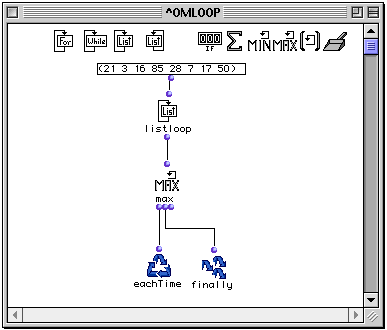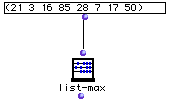OpenMusic Reference
maxi (max)

maxi (max)
(control module) -- returns the maximum value present among its collected elements
Syntax
maxi what? &optional retard
 |
Though it is called maxi in its LISP code, this function appears as max when used inside omloop . The reason eludes me.
—|—
Inputs
| name | data type(s) | comments |
|---|---|---|
| what? | a number | |
| retard | a function name or lambda function |
Output
| output | data type(s) | comments |
|---|---|---|
| first | a number | triggers the collection |
| second | a number | returns the state of the collection without evaluation |
| third | -4294967296 | reinitializes the counter, resetting it to -4294967296 |
Description
 |
maxi is part of a group of functions for performing iterative loops. They can only be used within an omloop patch window. Since they only function within the context of the entire repeating loop, they (or any function connected to them) cannot be evaluated directly within the patch window. You must evaluate the entire loop. See the entry on omloop for more information.
—|—
maxi is a type of collector. It returns the highest value of all the results of the loop.
Like all collectors, maxi has three outputs:
The first output triggers the collector, evaluating whatever is connected to it. The resulting number is then compared with the stored result of previous evaluations. If it is higher, it replaces the stored result, otherwise, the stored result is kept. It is usually connected to eachTime . The value carried by the connection itself is the highest value thus far encountered among the repeated evaluations, which you can verify by placing the lisp function print between the first output and eachTime .
The second output returns the current state of the collector, without evaluating whatever is connected to it. It is usually connected to finally so that you can get the results of the comparison.
The third output reinitializes the collector, resetting it to -4294967296. The value carried by the connection is always -429496729. (For those curious, this crazy number is the lowest value that a 32-bit integer can represent (the sign is not carried among the bits representing the numeric value of the number))
Examples
Using maxi

This simple example passes uses listloop to pass each of the list values individually to maxi . The highest value is retained:
? OM->85
A simpler solution would have been to plug that list directly into the list- max function:

| Prev | Home | Next |
|---|---|---|
| minim (min) | Up | listing |